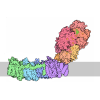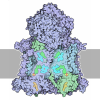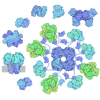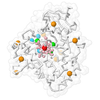[English] 日本語
 Yorodumi
Yorodumi- PDB-9lrr: Cryo-EM structure of Na+-translocating NADH-ubiquinone oxidoreduc... -
+ Open data
Open data
- Basic information
Basic information
| Entry | Database: PDB / ID: 9lrr | |||||||||||||||
|---|---|---|---|---|---|---|---|---|---|---|---|---|---|---|---|---|
| Title | Cryo-EM structure of Na+-translocating NADH-ubiquinone oxidoreductase NqrB-G141A mutant from Vibrio cholerae with bound korormicin A | |||||||||||||||
 Components Components | (Na(+)-translocating NADH-quinone reductase subunit ...) x 6 | |||||||||||||||
 Keywords Keywords | MEMBRANE PROTEIN / Na+-NQR / Na+ transporter / inhibitor / oxidoreductase / drug resistant | |||||||||||||||
| Function / homology |  Function and homology information Function and homology informationriboflavin binding / NADH:ubiquinone reductase (Na+-transporting) / Gram-negative-bacterium-type cell wall / oxidoreductase activity, acting on NAD(P)H, quinone or similar compound as acceptor / sodium ion transport / FAD binding / respiratory electron transport chain / transmembrane transport / 2 iron, 2 sulfur cluster binding / FMN binding ...riboflavin binding / NADH:ubiquinone reductase (Na+-transporting) / Gram-negative-bacterium-type cell wall / oxidoreductase activity, acting on NAD(P)H, quinone or similar compound as acceptor / sodium ion transport / FAD binding / respiratory electron transport chain / transmembrane transport / 2 iron, 2 sulfur cluster binding / FMN binding / electron transfer activity / metal ion binding / plasma membrane Similarity search - Function | |||||||||||||||
| Biological species |  Vibrio cholerae O395 (bacteria) Vibrio cholerae O395 (bacteria) | |||||||||||||||
| Method | ELECTRON MICROSCOPY / single particle reconstruction / cryo EM / Resolution: 2.68 Å | |||||||||||||||
 Authors Authors | Ishikawa-Fukuda, M. / Kishikawa, J. / Kato, T. / Murai, M. | |||||||||||||||
| Funding support |  Japan, 4items Japan, 4items
| |||||||||||||||
 Citation Citation |  Journal: Biochemistry / Year: 2025 Journal: Biochemistry / Year: 2025Title: Structural Elucidation of the Mechanism for Inhibitor Resistance in the Na-Translocating NADH-Ubiquinone Oxidoreductase from . Authors: Moe Ishikawa-Fukuda / Jun-Ichi Kishikawa / Takahiro Masuya / Takeshi Ito / Nicole L Butler / Danielle McFee / Takayuki Kato / Blanca Barquera / Hideto Miyoshi / Masatoshi Murai /   Abstract: Na-translocating NADH-ubiquinone oxidoreductase (Na-NQR) is a unique redox-driven Na-pump. Since this enzyme is exclusively found in prokaryotes, including the human pathogens and , it is a ...Na-translocating NADH-ubiquinone oxidoreductase (Na-NQR) is a unique redox-driven Na-pump. Since this enzyme is exclusively found in prokaryotes, including the human pathogens and , it is a promising target for highly selective antibiotics. Korormicin A, a natural product, and a specific and potent inhibitor of Na-NQR, may become a lead compound for the relevant drug design. We previously showed that the G141A mutation in the NqrB subunit (NqrB-G141A) confers moderate resistance to korormicin A (about 100-fold). However, the efficiency of photoaffinity labeling of the mutant enzyme by a photoreactive korormicin derivative was the same as in the wild-type enzyme. Because of these apparently conflicting results, the molecular mechanism underlying the korormicin A-resistance remains elusive. In the present study, we determined the cryo-EM structure of the NqrB-G141A mutant in the presence of bound korormicin A, and compared it to the corresponding structure from the wild-type enzyme. The toxophoric moiety of korormicin A binds to the mutant enzyme similarly to how it binds to the wild type. However, the added bulk of the alanine-141 excludes the alkyl side chain from the binding cavity, resulting in a decrease in the binding affinity. In fact, isothermal titration calorimetry revealed that the binding affinity of korormicin to the NqrB-G141A mutant is significantly weaker compared to the wild-type. Altogether, we conclude that the inhibitory potency of korormicin A is weaker in the NqrB-G141A mutant due to the decrease in its binding affinity to the altered binding cavity. | |||||||||||||||
| History |
|
- Structure visualization
Structure visualization
| Structure viewer | Molecule:  Molmil Molmil Jmol/JSmol Jmol/JSmol |
|---|
- Downloads & links
Downloads & links
- Download
Download
| PDBx/mmCIF format |  9lrr.cif.gz 9lrr.cif.gz | 392 KB | Display |  PDBx/mmCIF format PDBx/mmCIF format |
|---|---|---|---|---|
| PDB format |  pdb9lrr.ent.gz pdb9lrr.ent.gz | 307.9 KB | Display |  PDB format PDB format |
| PDBx/mmJSON format |  9lrr.json.gz 9lrr.json.gz | Tree view |  PDBx/mmJSON format PDBx/mmJSON format | |
| Others |  Other downloads Other downloads |
-Validation report
| Summary document |  9lrr_validation.pdf.gz 9lrr_validation.pdf.gz | 1.7 MB | Display |  wwPDB validaton report wwPDB validaton report |
|---|---|---|---|---|
| Full document |  9lrr_full_validation.pdf.gz 9lrr_full_validation.pdf.gz | 1.7 MB | Display | |
| Data in XML |  9lrr_validation.xml.gz 9lrr_validation.xml.gz | 64.9 KB | Display | |
| Data in CIF |  9lrr_validation.cif.gz 9lrr_validation.cif.gz | 97.5 KB | Display | |
| Arichive directory |  https://data.pdbj.org/pub/pdb/validation_reports/lr/9lrr https://data.pdbj.org/pub/pdb/validation_reports/lr/9lrr ftp://data.pdbj.org/pub/pdb/validation_reports/lr/9lrr ftp://data.pdbj.org/pub/pdb/validation_reports/lr/9lrr | HTTPS FTP |
-Related structure data
| Related structure data |  63340MC M: map data used to model this data C: citing same article ( |
|---|---|
| Similar structure data | Similarity search - Function & homology  F&H Search F&H Search |
- Links
Links
- Assembly
Assembly
| Deposited unit | 
|
|---|---|
| 1 |
|
- Components
Components
-Na(+)-translocating NADH-quinone reductase subunit ... , 6 types, 6 molecules ABCDEF
| #1: Protein | Mass: 48680.734 Da / Num. of mol.: 1 Source method: isolated from a genetically manipulated source Source: (gene. exp.)  Vibrio cholerae O395 (bacteria) / Gene: nqrA, VC0395_A1884, VC395_2411 / Production host: Vibrio cholerae O395 (bacteria) / Gene: nqrA, VC0395_A1884, VC395_2411 / Production host:  Vibrio cholerae O395 (bacteria) Vibrio cholerae O395 (bacteria)References: UniProt: A5F5X1, NADH:ubiquinone reductase (Na+-transporting) |
|---|---|
| #2: Protein | Mass: 45404.906 Da / Num. of mol.: 1 / Mutation: G141A Source method: isolated from a genetically manipulated source Details: NqrB-G141A / Source: (gene. exp.)  Vibrio cholerae O395 (bacteria) / Gene: nqrB, VC0395_A1883, VC395_2410 / Production host: Vibrio cholerae O395 (bacteria) / Gene: nqrB, VC0395_A1883, VC395_2410 / Production host:  Vibrio cholerae O395 (bacteria) Vibrio cholerae O395 (bacteria)References: UniProt: A5F5X0, NADH:ubiquinone reductase (Na+-transporting) |
| #3: Protein | Mass: 27652.270 Da / Num. of mol.: 1 Source method: isolated from a genetically manipulated source Source: (gene. exp.)  Vibrio cholerae O395 (bacteria) / Gene: nqrC, VC0395_A1882, VC395_2409 / Production host: Vibrio cholerae O395 (bacteria) / Gene: nqrC, VC0395_A1882, VC395_2409 / Production host:  Vibrio cholerae O395 (bacteria) Vibrio cholerae O395 (bacteria)References: UniProt: A5F5Y7, NADH:ubiquinone reductase (Na+-transporting) |
| #4: Protein | Mass: 22853.217 Da / Num. of mol.: 1 Source method: isolated from a genetically manipulated source Source: (gene. exp.)  Vibrio cholerae O395 (bacteria) / Gene: nqrD, VC0395_A1881, VC395_2408 / Production host: Vibrio cholerae O395 (bacteria) / Gene: nqrD, VC0395_A1881, VC395_2408 / Production host:  Vibrio cholerae O395 (bacteria) Vibrio cholerae O395 (bacteria)References: UniProt: A5F5Y6, NADH:ubiquinone reductase (Na+-transporting) |
| #5: Protein | Mass: 21481.678 Da / Num. of mol.: 1 Source method: isolated from a genetically manipulated source Source: (gene. exp.)  Vibrio cholerae O395 (bacteria) / Gene: nqrE, VC0395_A1880, VC395_2407 / Production host: Vibrio cholerae O395 (bacteria) / Gene: nqrE, VC0395_A1880, VC395_2407 / Production host:  Vibrio cholerae O395 (bacteria) Vibrio cholerae O395 (bacteria)References: UniProt: A5F5Y5, NADH:ubiquinone reductase (Na+-transporting) |
| #6: Protein | Mass: 45942.363 Da / Num. of mol.: 1 Source method: isolated from a genetically manipulated source Source: (gene. exp.)  Vibrio cholerae O395 (bacteria) / Gene: nqrF, VC0395_A1879, VC395_2406 / Production host: Vibrio cholerae O395 (bacteria) / Gene: nqrF, VC0395_A1879, VC395_2406 / Production host:  Vibrio cholerae O395 (bacteria) Vibrio cholerae O395 (bacteria)References: UniProt: A5F5Y4, NADH:ubiquinone reductase (Na+-transporting) |
-Sugars , 1 types, 2 molecules 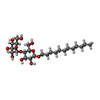
| #9: Sugar |
|---|
-Non-polymers , 8 types, 46 molecules 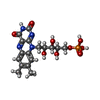


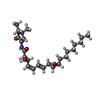

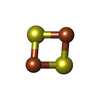
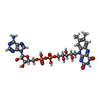








| #7: Chemical | | #8: Chemical | ChemComp-RBF / | #10: Chemical | #11: Chemical | ChemComp-IQT / | #12: Chemical | ChemComp-CA / | #13: Chemical | #14: Chemical | ChemComp-FAD / | #15: Water | ChemComp-HOH / | |
|---|
-Details
| Has ligand of interest | Y |
|---|---|
| Has protein modification | N |
-Experimental details
-Experiment
| Experiment | Method: ELECTRON MICROSCOPY |
|---|---|
| EM experiment | Aggregation state: PARTICLE / 3D reconstruction method: single particle reconstruction |
- Sample preparation
Sample preparation
| Component | Name: Na(+)-translocating NADH-quinone reductase / Type: COMPLEX / Details: NqrB-G141A mutant / Entity ID: #1-#6 / Source: RECOMBINANT | |||||||||||||||||||||||||
|---|---|---|---|---|---|---|---|---|---|---|---|---|---|---|---|---|---|---|---|---|---|---|---|---|---|---|
| Molecular weight | Value: 0.214 MDa / Experimental value: NO | |||||||||||||||||||||||||
| Source (natural) | Organism:  Vibrio cholerae O395 (bacteria) Vibrio cholerae O395 (bacteria) | |||||||||||||||||||||||||
| Source (recombinant) | Organism:  Vibrio cholerae O395 (bacteria) Vibrio cholerae O395 (bacteria) | |||||||||||||||||||||||||
| Buffer solution | pH: 8 | |||||||||||||||||||||||||
| Buffer component |
| |||||||||||||||||||||||||
| Specimen | Conc.: 10 mg/ml / Embedding applied: NO / Shadowing applied: NO / Staining applied: NO / Vitrification applied: YES | |||||||||||||||||||||||||
| Specimen support | Grid material: COPPER / Grid mesh size: 200 divisions/in. / Grid type: Quantifoil R1.2/1.3 | |||||||||||||||||||||||||
| Vitrification | Instrument: FEI VITROBOT MARK IV / Cryogen name: ETHANE / Humidity: 100 % / Chamber temperature: 277 K |
- Electron microscopy imaging
Electron microscopy imaging
| Experimental equipment |  Model: Titan Krios / Image courtesy: FEI Company |
|---|---|
| Microscopy | Model: TFS KRIOS |
| Electron gun | Electron source:  FIELD EMISSION GUN / Accelerating voltage: 300 kV / Illumination mode: FLOOD BEAM FIELD EMISSION GUN / Accelerating voltage: 300 kV / Illumination mode: FLOOD BEAM |
| Electron lens | Mode: BRIGHT FIELD / Nominal magnification: 81000 X / Nominal defocus max: 1800 nm / Nominal defocus min: 800 nm / Cs: 0.131 mm / C2 aperture diameter: 50 µm |
| Specimen holder | Cryogen: NITROGEN / Specimen holder model: FEI TITAN KRIOS AUTOGRID HOLDER |
| Image recording | Electron dose: 65 e/Å2 / Film or detector model: GATAN K3 BIOQUANTUM (6k x 4k) / Num. of grids imaged: 1 |
| EM imaging optics | Energyfilter name: GIF Bioquantum / Energyfilter slit width: 20 eV / Spherical aberration corrector: Image corrector |
- Processing
Processing
| EM software |
| ||||||||||||||||||||||||||||||||||||||||||||||||||
|---|---|---|---|---|---|---|---|---|---|---|---|---|---|---|---|---|---|---|---|---|---|---|---|---|---|---|---|---|---|---|---|---|---|---|---|---|---|---|---|---|---|---|---|---|---|---|---|---|---|---|---|
| CTF correction | Type: NONE | ||||||||||||||||||||||||||||||||||||||||||||||||||
| Particle selection | Num. of particles selected: 1961776 | ||||||||||||||||||||||||||||||||||||||||||||||||||
| Symmetry | Point symmetry: C1 (asymmetric) | ||||||||||||||||||||||||||||||||||||||||||||||||||
| 3D reconstruction | Resolution: 2.68 Å / Resolution method: FSC 0.143 CUT-OFF / Num. of particles: 1035957 / Algorithm: FOURIER SPACE / Symmetry type: POINT | ||||||||||||||||||||||||||||||||||||||||||||||||||
| Atomic model building | Protocol: FLEXIBLE FIT / Space: REAL | ||||||||||||||||||||||||||||||||||||||||||||||||||
| Atomic model building | PDB-ID: 7XK7 Accession code: 7XK7 / Source name: PDB / Type: experimental model | ||||||||||||||||||||||||||||||||||||||||||||||||||
| Refinement | Highest resolution: 2.68 Å Stereochemistry target values: REAL-SPACE (WEIGHTED MAP SUM AT ATOM CENTERS) | ||||||||||||||||||||||||||||||||||||||||||||||||||
| Refine LS restraints |
|
 Movie
Movie Controller
Controller


 PDBj
PDBj
